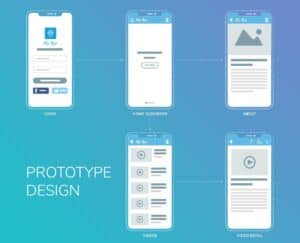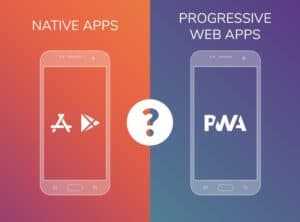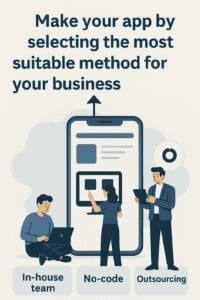Application Design Steps
Whether you want to create an app to complement your website, reach a new audience for your business, or just think you have a great idea for a new app, in this article we’ll explore every step of the way to creating a mobile app from scratch. To create an app, you need an innovative project, expertise, time, and, most importantly, good reasons.
we found at least 5 reasons that can motivate you to create an app:
- Improve brand visibility and reputation
- Offer specific "ad-hoc" features to your customers
- Generate interactions tailored to your business needs.
- Take advantage of the ubiquity of mobile phones.
- Improve speed and quality of interactions for your users.
The main steps of application design
1. Get your app idea on paper
According to a recent report published by Data.ai in January 2025, more than 316 billion mobile apps were downloaded worldwide in 2024, reflecting the continued growth of the app market. As we enter 2025, this number is expected to continue rising, highlighting the importance of distinctive app concepts and user experience in a highly competitive market.

The first stage of your app building is to understand what your app is aiming to deliver:
Before delving into the details of design or development, it's essential to begin with a clear and deep understanding of the app's concept and what it aims to offer the user, This stage is the foundation upon which everything else is built, A good understanding at this stage not only saves time and money, but also ensures that the final product is precisely targeted to the needs of the market and the user.
- Set the goals for your app: study your market and define a concept for your app. To do that, it would be helpful to answer these questions, What is your target audience?
Plan your App Design: create a mockup. App design plays a vital role in creating an engaging experience for your users. Researches on websites reading habits and interactions have shown that it takes as little as 500 milliseconds for a user to decide whether to stay on your screen or leave. Once that user decides to stay on screen, it takes about 5 to 10 seconds to decide if he will keep to read the full content.
Main factors that determine this decision are Visual Complexity and prototypicality : the complexity of the visual design and the representativeness of a design for a given category of websites. In other words, if you want to be successful with your app design and deliver a great user experience for your app, you need to keep your app design as simple and clear as possible, not overloaded, fluid.
At the same time, you would avoid unusual / uncommon layouts and opt for a familiar look and feel typical of a given type of mobile apps.
Sketching wireframes :
Allows you to focus on the essential parts of your interface, before starting to work on design elements and patterns.
- starting to work with design elements and styles t will make much easier to identify where to place the key components of the app and to make them accessible to the user, Using wireframes also allows you to make changes to the interface sketch a lot faster than if you were working with a final mockup.
- User Interface design (UI): the look and feel of an app plays a crucial role in the success of an app. Mobile UI is a set of touchscreen graphical elements that determine how users would interact with your app. Some of them are navigation menus, icons, shortcuts, but also feedback features (sounds, lights, texts), colors and fonts. The user interface should be as simple as possible and remain consistent throughout the app.
- User Experience (UX): this is the point of view of your users. User Experience is the quality and richness of the user journey overall. This involves the quality of the user interface as well as other elements, such as loading time, depth of app structure, content length, duration of journeys to reach a goal or find content given. It will impact how they see your brand. Also remember your users are browsing your app on a small screen (According to Apple’s recommendation, about 44 pixels square is an appropriate size for a touch.)
- 3-click rule : to create a successful app, make your app easy for people to use. That means designing it so they don’t have to work hard to figure it out and have fun effortlessly. Conversely, when a mobile app is hard to grasp, it reduces user interactions and engagement. So, be guided by the 3-click rule which suggests that users should be able to find any information on a website by requiring no more than three mouse clicks. Don’t strictly follow this rule, just keep the 3-click rule in mind in order to design a navigation experience within your app.
2. Build a Native app or a PWA, based on your needs
When it comes to mobile app development, there are several approaches that all have their pros and cons, benefits and constraints.
However, it is worth mentioning the 2 main app development approaches for our purposes: Native and PWA.

Native Apps and Progressive Web Apps (PWA)
Native app:
- A native mobile app is a software application developed to run on a specific type of device and operating system. Because it was designed to run on a given platform, a native app has the ability to use that device's hardware and software resources. Native apps allow for better performance
- Native technologies have always been at the forefront of mobile development. This is due to the fact that this method offers reliable and high performance products that can access a wide variety of native APIs and features available on smartphones or tablets. To make an app with native coding means that you will be creating independent outputs for each specific operating system, which will help deliver a refined interface for different devices.
- In 10 years Apple's App Store catalogue has grown from 500 to nearly 2 million apps available today. Another 2.4 million are distributed through Google Play Store: mobile applications are now part of our daily lives.
- Native apps account for over 80% of all mobile traffic
- There are mainly two types of mobile operating systems: Apple's iOS and Google's Android.
Progressive Web App:
- A Progressive Web App (PWA) is an app that uses web features to give users a very similar experience to a native app. Unlike native apps, PWAs are a hybrid of regular web pages and mobile apps. The term "progressive" refers to the fact that they introduce new features and are initially perceived as traditional websites by users but, progressively, behave more and more like cross-platform mobile apps
- PWA is the perfect combination of web and native technologies. While they have the look and feel of a native app ( for example they can be installed on the Home Screen of the user’s device ), you don’t need to go through the Stores publication process.
- PWA is the perfect combination of web and native technologies. While they have the look and feel of a native app ( for example they can be installed on the Home Screen of the user’s device ), you don’t need to go through the Stores publication process.
- PWA doesn’t require download and adapt to mobile, tablets, and desktop.
- Benefit from SEO and are indexed on search engines
- Thanks to Service Workers PWAs also works offline
- 67% of web traffic comes from mobile, PWA ensures a mobile presence adapted to all devices.
3. Make your app by selecting the most suitable method for your business

Once you have chosen which type of app best suits your business needs, it is time to choose how to create your own app.
Mobile app development is the process of developing software suitable to run on mobile devices, as smartphones or tablets.
Although it allows to design a perfect match between your app idea and device capabilities, app development requires lots of skills and expertise, and is highly time consuming. Furthermore, usually it’s a quite expensive service .
On the other hand, an App Builder provides a cost-effective option to make an app without coding.
Further down, we’ll explore both solutions and give some tips for choosing the one that best suits your needs to build an app.
You have 3 main app development methods:
1.Develop your own app yourself
If you are looking for how to make an app for free, then developing an app by yourself is definitely the way to go. This first option requires significant time and skills. Natives mobile applications are specific to each Operating System (OS), therefore, skills in several programming languages are required: Objective-C and Swift for iOS apps; Java or Kotlin for Android apps.
However, if you have required skills, this option will let you achieve the app you need without any limits. Otherwise, you should start by learning how to code for apps. A viable option is to use a coding app which will help you to learn fundamental concepts and gain confidence in your coding skills.
2.Hire an Agency or a freelance developer
There are many programming companies and freelance developers available online, and finding one should be easy, The deciding factor here is the cost and quality of the service.
In fact, hiring a company like alexapps to develop your app is the most expensive, However, if you have the resources, it is the absolute best way to get the app you want without any compromises.
3.Use an App Builder
An app builder is similar in concept to website builders like WordPress (a content management system that lets you modify the look of your website without coding), a no-code development platform, and a software tool that allows users to create a mobile app without coding and distribute it across different app stores.
Most app developers provide a drag-and-drop visual editor within the user interface, allowing users to preview their app in real time as it's being created. This is a great option to save time and money while still delivering a high-quality app.
Before delving into the details of design or development, it's essential to begin with a clear and deep understanding of the app's concept and what it aims to offer to the user. This stage is the foundation upon which everything else is built. A good understanding at this stage not only saves time and money, but also ensures that the final product is precisely targeted to the needs of the market and the user.
4. Create an app by alexapps
After making all the tough decisions, it’s time to get to work.
Obviously, the process of building an app will differ depending on the method you choose. We will assume that you chose a development company, specifically (alexapps).
With over 15 years of experience building apps with the latest technologies, you’ll be able to create a cross-platform app for iOS and Android devices, as well as a progressive web app, all from a single interface.

Advantages of creating an application with (alexapps)
- Application design and development: The company provides custom app design services for smartphones and tablets, with a focus on user experience and intuitive interface.
- Technical consulting: The company provides technical consulting to help improve digital performance and develop effective technology strategies.
- Website development: Design responsive websites that meet businesses' needs in terms of performance and attractive appearance.
- Technical support services: Providing continuous customer support to resolve any technical issues and ensure efficient business continuity.

